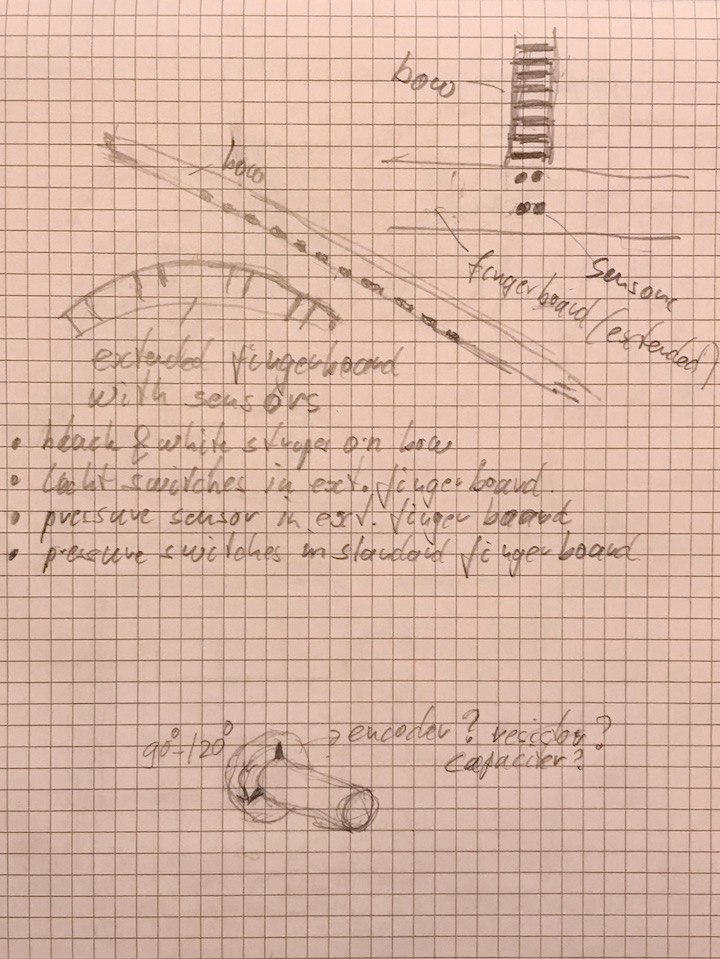Final Project 1st Drafts¶
Making a tangible machine from scratch is not new to me. I’ve done lots of brainstorms and ideations to answer the need for a technical solution from a customer. Managing teams that turn them into a real product is my job. So what I realise in my working life is always goal driven.
One of my challenges for fabacademy now is to make something that is not guided by the problem of others. I have to come up with my own idea and make something just for the fun of making it.
Requirements¶
Because that’s quite difficult for me I’m starting from an other angle: what do I like, what do I want to learn and what kind of product do I want to make? This list of criteria will help me to choose my projects.
- Of course, it must contain welded parts. This can’t be done at De Waag, but I have the equipment at my own workshop and will prepare them there.
- It should make sound. I like the rhythm of machines and the colour of its sound. This could be the objective of the product, but it could also be an intentional side effect.
- Design! It should look neat and well constructed. For me this goal is met when form and function synthesize.
- Some machines only move electrons or other non tangible properties.But I want it to move physically. So motors are part if it and preferably with power, wich allows me also to learn about how to drive a motor and especially a 3 phase induction or permanent magnet motor. This might need some power electronics. Haven’t seen much of that in the fabacademy yet, so I wonder if this is part of “learning to make anything” or part of the “(almost)”. ;-)
- Now about the UI: displays, knobs and switches are too easy, you just buy them. I want to make a special. As an example: throttle control handles are always a nuisance on motorbikes. They need cables, have play, wear out and are often messing up the tuning of your carburators. So it might be nice to make an electronic one to replace that.
I haven’t decided yet, but partly based on the requirements and partly on things that seem useful I have formulated a few projects.
Trolley¶
A project I already started is the design of a foldable trolley based on a pannier from the German brand Ortlieb. My wife has them for several years already but complained that it’s quite heavy when you have to carry them from your bicycle to the public transport. So I decided to make a foldable trolley for her.
It’s not suitable for my final project, but along the fabacademy I will try to improve some parts using the new skills and tools we discover. I’ve made a separate page for the trolley to keep track of the progress.
Leveling System¶
An other idea that came up is to make an automatic leveling system for our camper. It’s an old Merceds 508D van that has been transformed into a nice mobil home. Those leveling systems are not new, you can find several companies that sell these and mostly also install them in their workshop. Our Mercedes however is very heavy, about 4.500 kg, and a system will cost you over € 5000,- for such a vehicle.
This project would certainly need a lot of the techniques we learn, but I’m not sure if I’m going to proceed with this. For now I see it as a fall back scenario if the other ideas don’t work.
E-bike Conversion¶
Last but not least there’s the idea to transform my BMW R 1100 GS motorcycle into an E-bike.
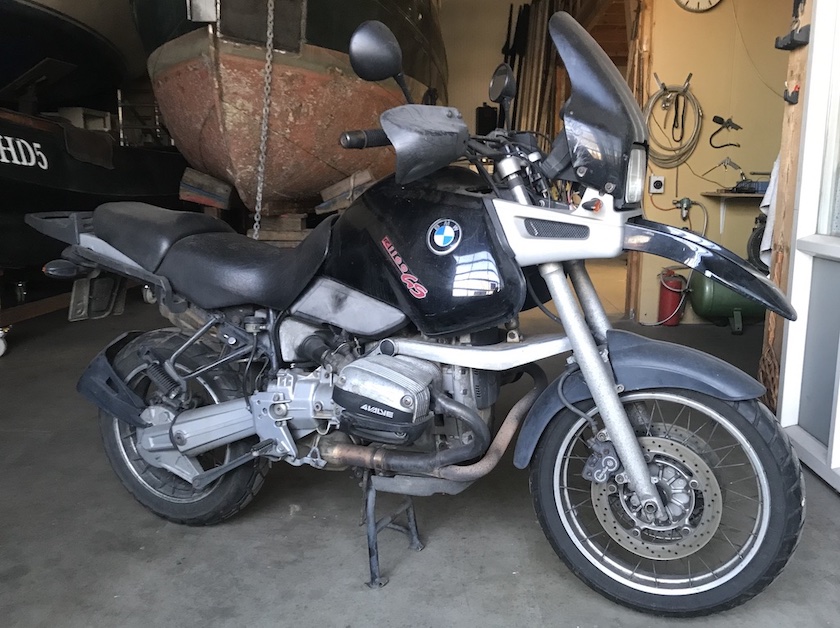
This is a project I will certainly proceed with, but I don’t know if it’s suitable as a final project. The scope is very large, even if the basic configuration is quite simple. You need a battery, an electric motor, a charger and a control system for battery and motor. But when diving into the details it turns out not that simple.
But anything useful for this project will be documented on the E-bike page.
To make a woeking E-bike within this half year of the fabacademy is almost impossible, but I definately would like to experiment with some parts. It helps me to understand the techniques better. I think I will start with the two following items:
- Design of a bidirectional motor drive for an induction or permanent magnet motor
- Design of a throttle control unit also useful for replacing the cable driven handle
Throttle Control¶
Challenge is here to get it integrated in the current handle. The brake and switches should keep working the way they do now. For the E-bike only tha handle is needed. It could have a position sensor or a potentiometer to give a proportional signal to the desired speed.
| throttle handle backside | throttle handle front |
|---|---|
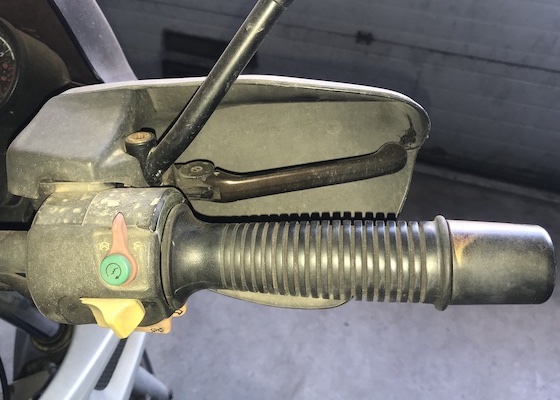 |
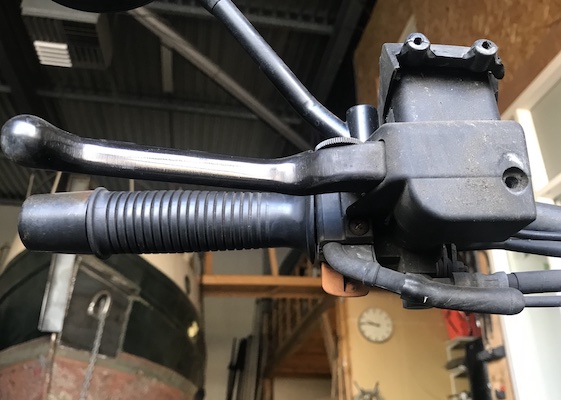 |
For the version that would replace the cables on the ICE (Internal Combustion Engine) also a stepper motor or angular motor for the throttle valve is needed. BTW: the BMW has position sensors on both carburators. Maybe it’s possible to get the signal out and use it to create a feedback loop for the control system.
Motor Driver¶
The Motor driver is the most important part for the E-bike apart from the batteries. First of all it needs to be bidirectional. It has to drive the motor to realise the desired speed, but in case of braking it should use the motor as a generator and store the energy in the battery.
Basic principle is to convert the DC of a battery into an AC for the motor with 120° phase shift. The frequency determines the speed of the motor and is variable and controlled by the throttle handle.
Let’s Make Noise¶
But if I’m not yet able to create an E-bike, what should I make? An AC motor mounted on a plate and which speed is changed by turning a handle is very uninteresting. If we go back to my requirements at the top of this page, two items weren’t covered yet, of all, numbers one and two: it should contain welded parts and it should make noise!
Well, let’s make a noise machine then! What if I could make the motor rotate a drum with circular sections made out of different materials. If a metal chain or somthing similar is dangling against this drum it will make noise when the drum rotates. By varying the speed the “pitch” will change and by varying the position the material and the character of the sound will change. Maybe even the height of the chain above the surface could change the loudness or maybe some other variable could be introduced. But that’s something to investigate when I start building some first prototypes or trials.
This is probably going to be my final project:
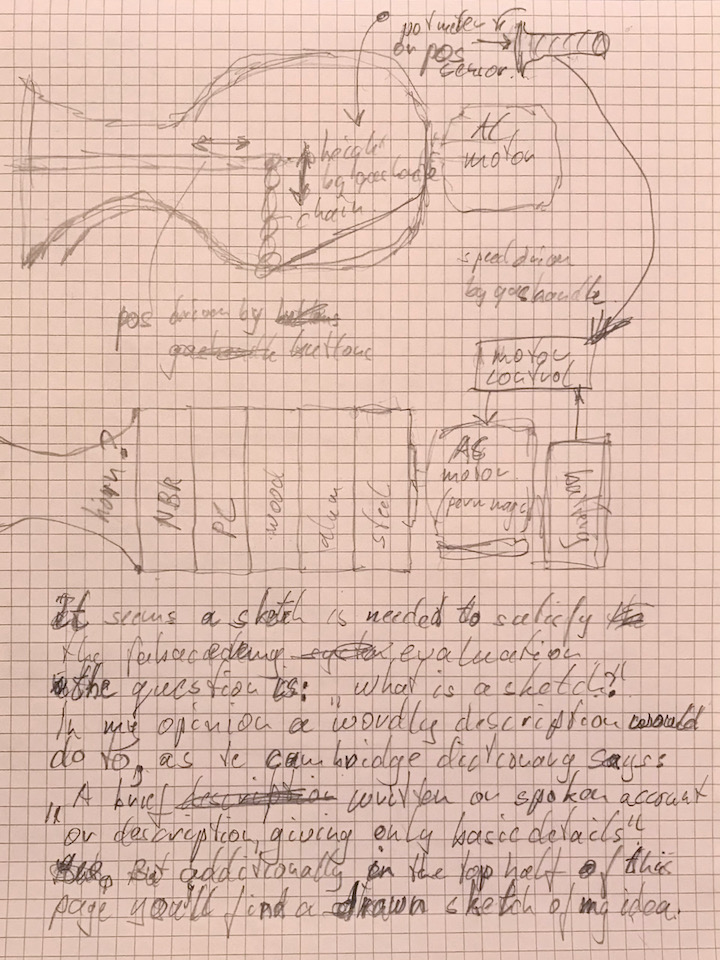
Noise Cello¶
One idea leads to an other. I have been playing the cello once, but haven’t touched it for several years. Maybe my motivation to pick up playing again if I made an electronic version. Yes, they already exist, but in that case they compare to the cello as the the electric guitar compares to the acoustic one. What I’m talking about here is a noise version.
One idea could be to put black and white lines on the “bow” and put optical sensors at the end of the finger board. That could be converted into sound. And maybe pressure switches in the higher parts of the fingerboard could be used to manipulate the pitch or the sound colour.
Maybe I should do fabacademy next year too …
